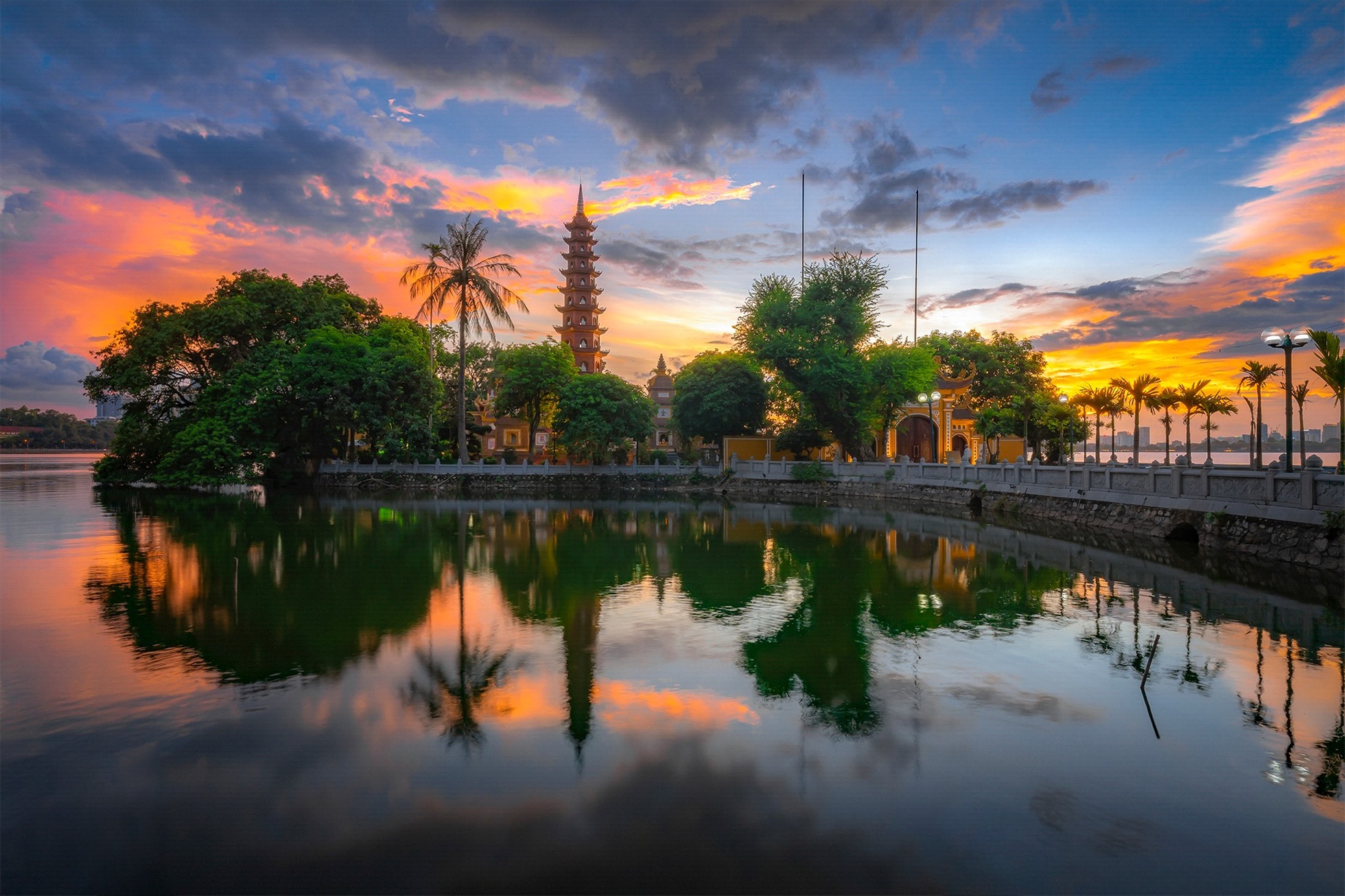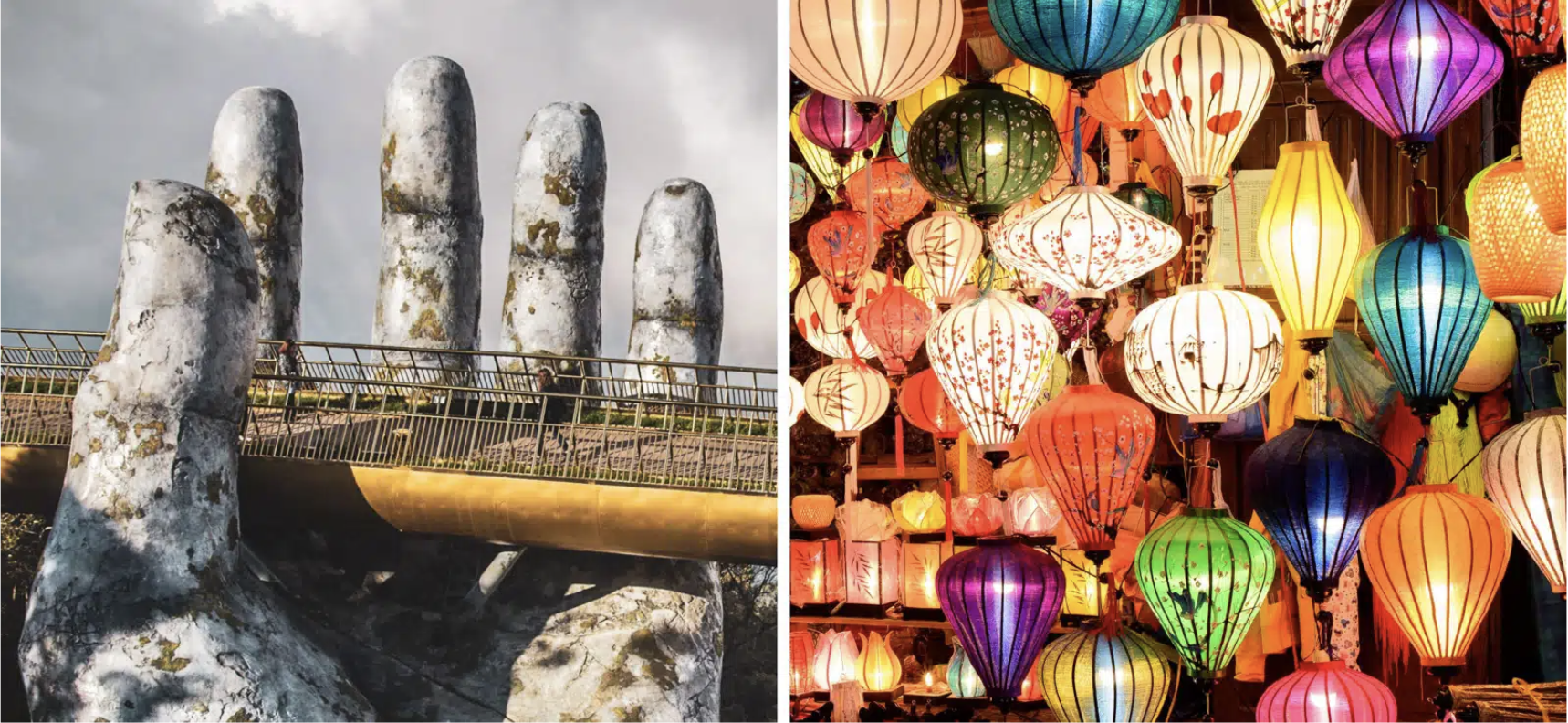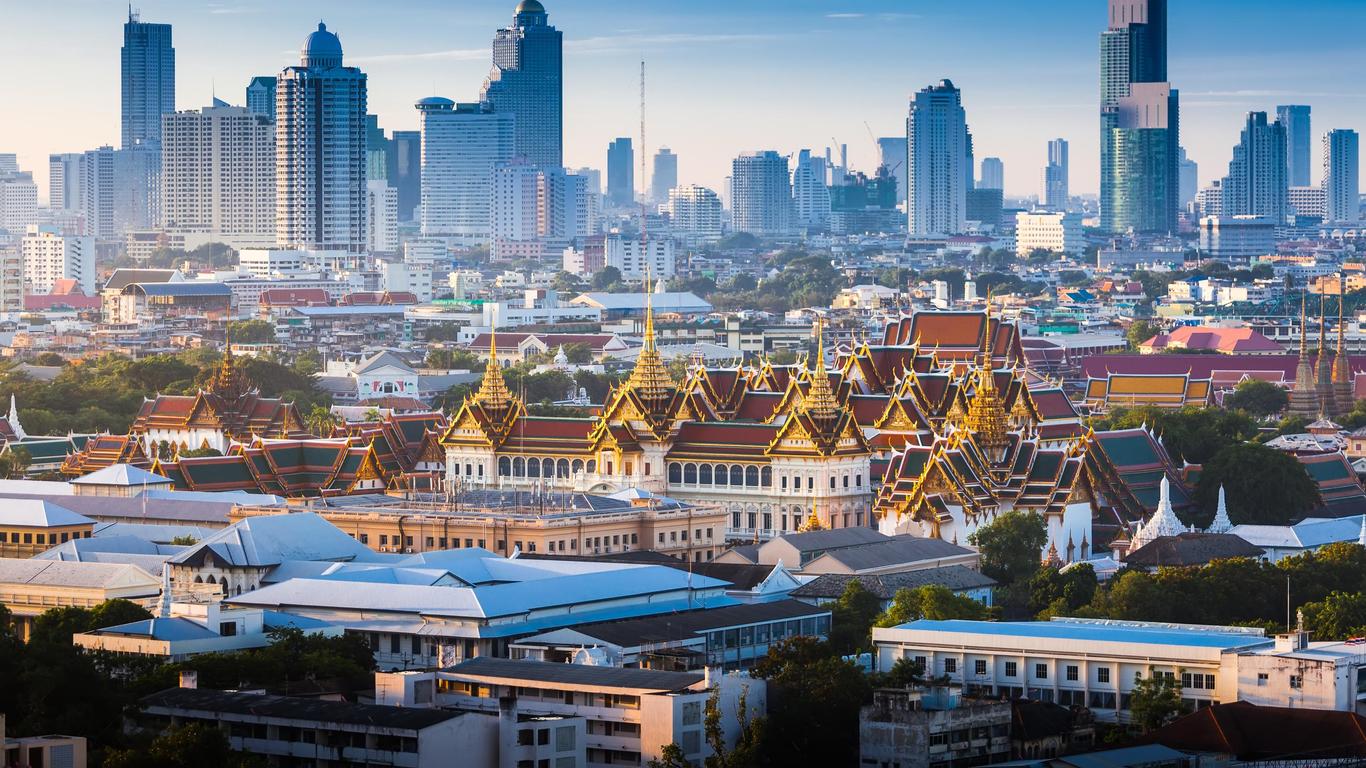Understanding Halong Bay weather is crucial for travelers, as the climate affects the availability and enjoyment of activities. This guide offers an overview of Halong Bay forecast to provide insights and tips for planning an unforgettable trip to this stunning destination.
1. Overview of Halong Bay Weather
Halong Bay is a UNESCO World Heritage site in northern Vietnam known for its emerald waters and towering limestone islands. Halong Bay forecast varies significantly throughout the year and greatly shapes visitors’ experiences.
Halong Bay weather by Month
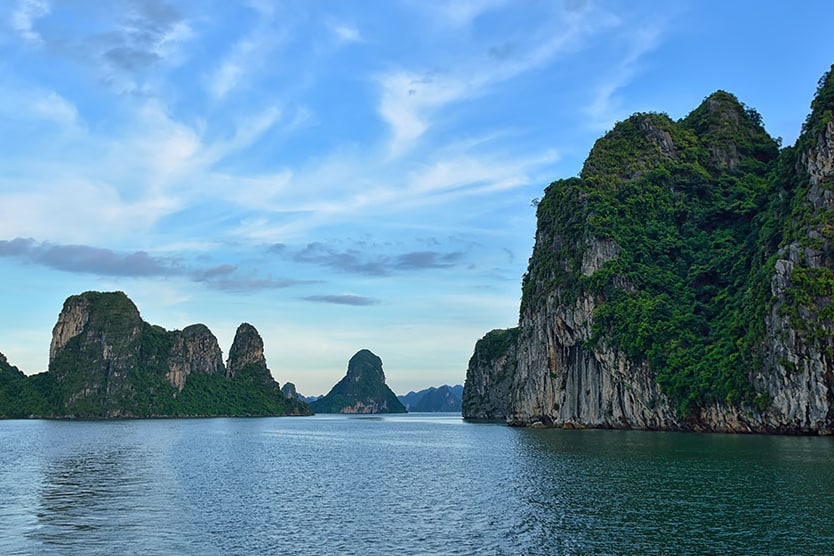
Halong Bay experiences four distinct seasons: spring, summer, autumn, and winter, each with unique weather conditions. Let’s explore the Halong Bay weather by month:
- March to April
From March to April is a pleasant season with temperatures ranging from 18°C to 28°C (64°F to 82°F). It’s an ideal time of year for sightseeing and exploring because it’s often misty and scenic due to moderate humidity and light rainfall.
- May to August
From May to August is hot and humid, with temperatures between 25°C and 35°C (77°F and 95°F). This season coincides with the monsoon, which brings heavy rainfall and occasional storms. Despite the heat, summer remains popular for water activities like swimming and kayaking, although visitors should be prepared for sudden weather changes.
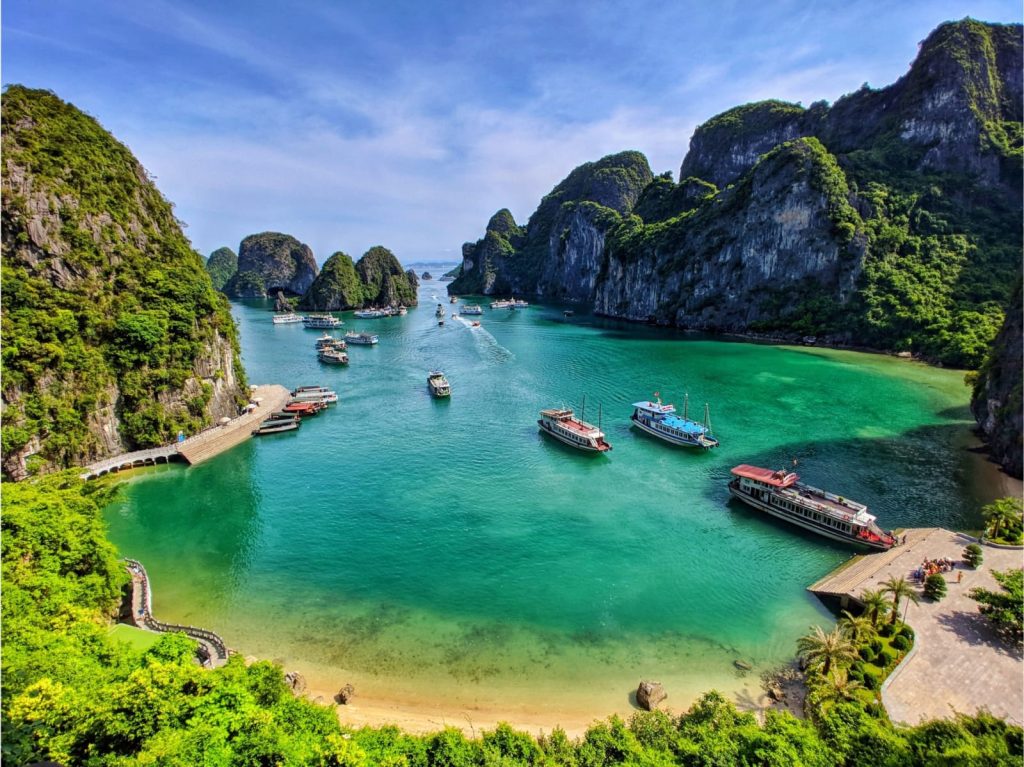
- September to November
From September to November is considered the best time to visit Halong Bay. The weather is cool and dry, with temperatures from 20°C to 28°C (68°F to 82°F). Clear skies and lower humidity make it perfect for outdoor activities and photography. Autumn signifies the conclusion of the typhoon season, which typically brings stable and enjoyable weather.
- December to February
From December to February is cool and dry, with temperatures between 10°C and 20°C (50°F to 68°F). While the cooler weather may not be ideal for swimming, the clear conditions and occasional fog create a serene atmosphere perfect for cruising and appreciating the bay’s beauty.
Temperature Fluctuations
Halong Bay’s temperatures vary widely throughout the year. The hottest months are June through August, with highs up to 35°C (95°F), while the coldest months are January and February, with lows around 10°C (50°F). These fluctuations are influenced by the region’s geographical location and monsoon winds.
Precipitation Patterns
Precipitation in Halong Bay peaks during the summer months. June, July, and August are the wettest, each receiving over 200mm (7.9 inches) of rainfall. These heavy rains are often accompanied by thunderstorms. In contrast, winter is relatively dry, with December and January receiving less than 30mm (1.2 inches) of rain each month.
2. Halong Bay Weather by Season
Halong Bay weather in Spring
Spring (From March to April) in Halong Bay features mild and pleasant weather, with temperatures between 18°C and 28°C (64°F to 82°F). This season is ideal for cruising because the calm and clear waters make it perfect for exploring the many islands and limestone formations. Visitors can enjoy sightseeing at famous spots like Sung Sot Cave and Ti Top Island, which offer beautiful panoramic views. Kayaking through peaceful waters and hidden lagoons is also recommended. The blooming flowers add to the bay’s magical charm, making it a great time for photography and outdoor activities like hiking and beach visits. Travelers should pack light clothing with layers for temperature changes and bring a rain jacket for occasional showers. It’s also a good idea to book accommodations and tours in advance, as spring is a popular time to visit.
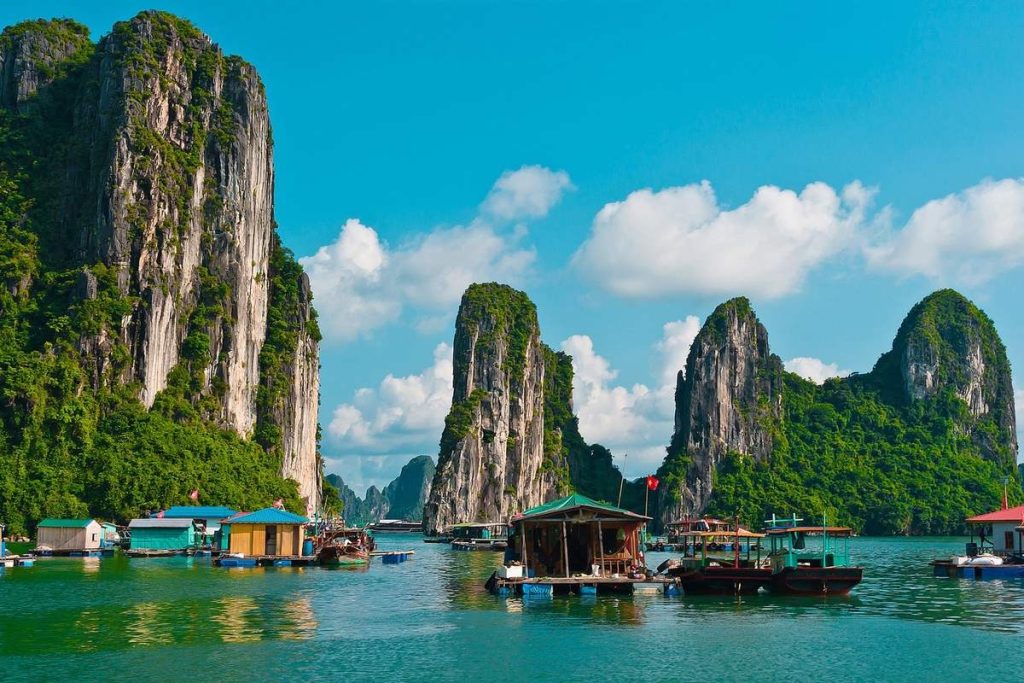
Halong Bay weather in Summer
Summer (From May to August) in Halong Bay is hot and humid, with temperatures from 25°C to 35°C (77°F to 95°F). This season also sees frequent showers and potential typhoons, which can disrupt travel plans. Despite the heat, it’s a great time for swimming, jet skiing, and other water sports in the warm waters. Visitors can explore floating fishing villages and lively local markets to experience local life. Nature tours to lush landscapes and waterfalls are also popular. It’s best to take cruises early or late afternoon to avoid the midday heat. Travelers should stay hydrated, wear breathable clothing, and monitor typhoon weather forecasts. Flexibility in planning and using insect repellent to prevent mosquito bites are also important.
Halong Bay weather in Autumn
Autumn (From September to November) is a great time to visit Halong Bay as it signals the end of the typhoon season. The weather is cool and dry, with temperatures from 15°C to 25°C (59°F to 77°F). Clear skies and calm seas make it perfect for extended cruises and exploring remote areas. With excellent visibility, sightseeing at caves, islands, and viewpoints is especially enjoyable. The pleasant weather is ideal for outdoor dining on cruise decks and taking stunning photos. Cultural tours to local heritage sites are also less crowded. Travelers should pack comfortable clothing with layers for cooler evenings and mornings, book accommodations and tours in advance, and bring good camera equipment. Sun protection is still important despite the cooler temperatures.
Halong Bay weather in Winter
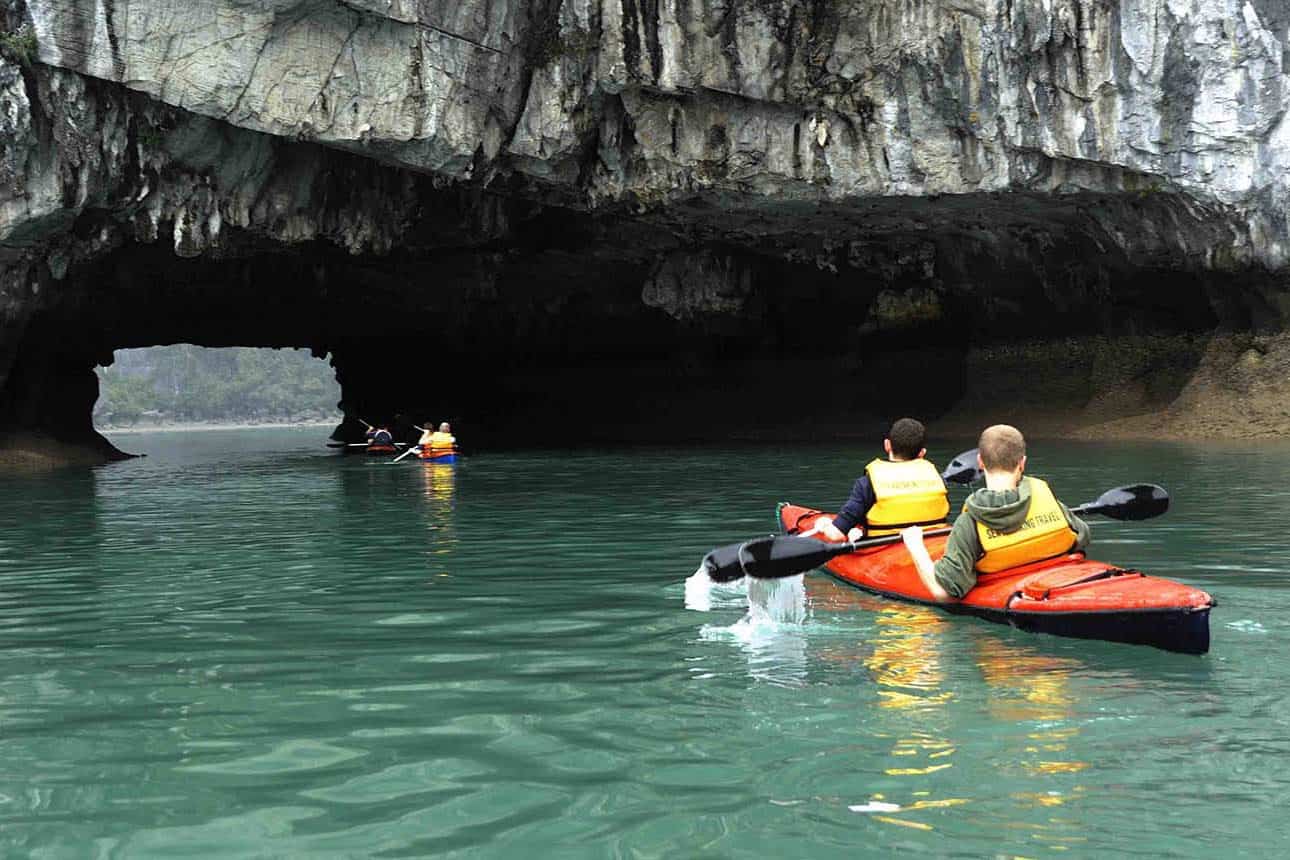
Winter (From December to February) in Halong Bay is cool and often misty, with temperatures from 10°C to 20°C (50°F to 68°F). The fog creates a unique and serene atmosphere. This season is great for misty cruises, giving a different view of the bay’s enchanting landscapes. It’s also a good time for cultural visits to temples, historical sites, and museums. Market tours to enjoy seasonal delicacies and warm dishes are popular, too. The cooler air is perfect for hiking and exploring nearby trails. Travelers should bring warm clothing, dress in layers for varying temperatures, and be prepared for reduced visibility due to fog. Winter is quieter with fewer tourists, making it ideal for a peaceful visit. Those sensitive to cold should take extra measures to stay warm.
3. Best Time to Visit Halong Bay Weather By Month
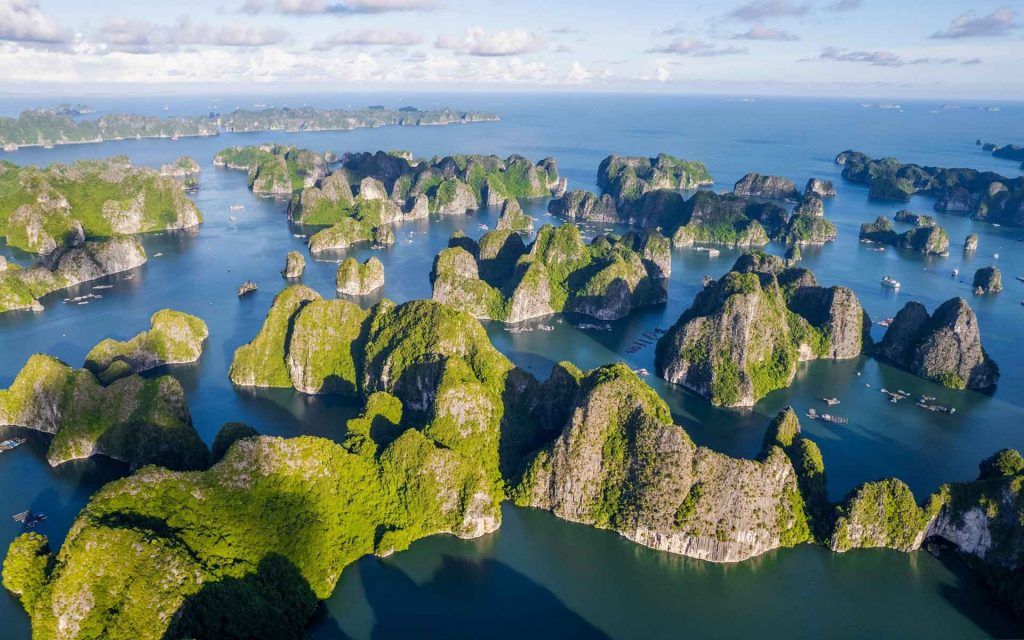
If you want to travel Halong Bay, Vietnam then the big question is “When is the best time to visit Halong Bay?”
Visiting Halong Bay, a breathtaking natural wonder in Vietnam, requires considering the weather for the best experience. The great time to visit Halong Bay, discover by UNESCO World Heritage Site, is October to December. This period offers cool and dry weather, with temperatures ranging from 15-25°C (59-77°F). It’s ideal for cruising and outdoor activities thanks to pleasant temperatures, clear skies, and calm seas. Remember that it’s the busiest season, so expect crowds and higher prices for accommodations and tours.
The next best time to visit Halong Bay is March to April, known for warm and dry weather averaging 18-27°C (64-81°F). Lower humidity makes it comfortable for sightseeing and exploring islands and caves. There are fewer tourists compared to peak season, enhancing the overall experience. However, there’s a slightly higher chance of rain compared to October-December.
The following best time to visit Halong Bay is summer, from May to September, with hot and humid conditions ranging from 25-35°C (77-95°F). Expect frequent showers and possible typhoons, which can disrupt plans. The bay’s lush greenery peaks during this time, and there are fewer tourists, leading to lower prices. If you can handle the heat and humidity, it can be a good time to visit, but keep a close watch on the weather.
Lastly, January to February is winter, it also the good time to visit Halong Bay, with cool and often misty weather around 10-20°C (50-68°F). The colder weather and fog may not appeal to everyone, and views can be obscured. Despite these drawbacks, fewer tourists mean a quieter and more intimate experience of the bay.
4. Travel Tips for Halong Bay weather by Season
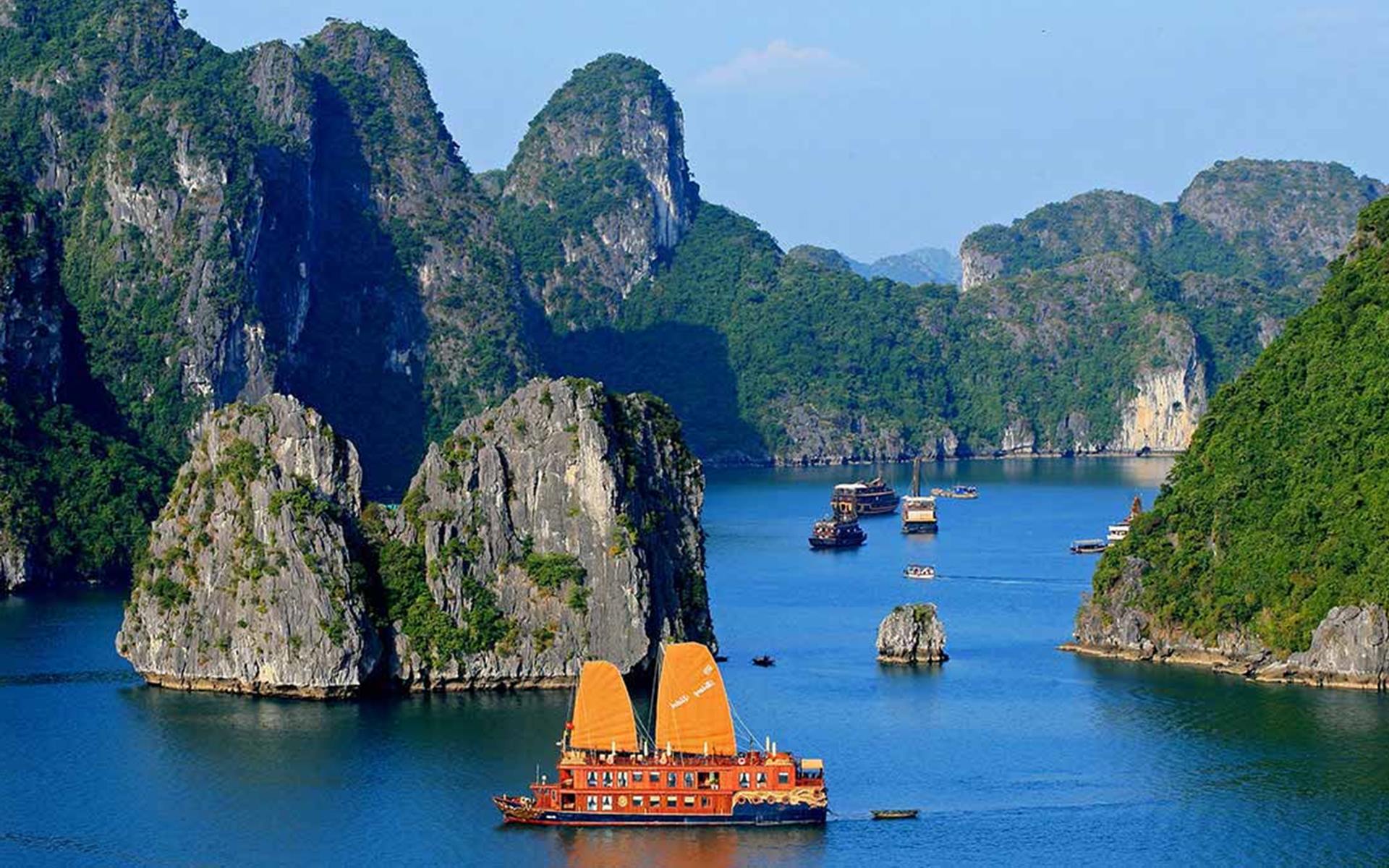
Planning a trip to Halong Bay requires careful consideration of the weather to ensure a pleasant and safe experience. Here are some essential weather-related travel tips to help you maximize your visit:
- Firstly, it is crucial to stay updated with weather forecasts. Monitoring forecasts before and during your trip will help you pack appropriately and prepare for any weather changes that may occur.
- Pack light layers regardless of the season. It’s essential to have clothing that can be easily added or removed as temperatures fluctuate throughout the day. It’s also wise to include a light rain jacket or poncho in case of unexpected showers.
- Sun protection is vital due to Halong Bay’s sunny conditions, particularly during the dry season. Don’t forget to bring sunscreen, a hat, and sunglasses to shield yourself from strong UV rays, even when it’s cloudy.
- Choose comfortable and sturdy footwear for walking and exploring uneven terrain, especially if you plan to visit caves or trek on islands.
- During the summer (May to September), be mindful of local guidelines and warnings regarding typhoons or heavy rainfall. Follow instructions from tour operators and local authorities to ensure safety.
- Flexibility with your plans is key, as the weather in Halong Bay can change rapidly, especially during the summer months. Have backup plans or be ready to adjust your itinerary if certain activities become unsafe or impractical due to weather conditions.
- Booking tours and accommodations well in advance, particularly during peak seasons (October to December and March to April), ensures you secure your preferred options and avoid last-minute price increases.
- Consider visiting during shoulder seasons (early October or late April) when the weather is still pleasant, but tourist numbers are lower, offering a quieter and more relaxed experience.
- Respect Halong Bay’s delicate ecosystem by avoiding littering, using reusable water bottles, and choosing eco-friendly tour operators committed to environmental sustainability.
- Stay informed about local news and advisories, especially during typhoon season. Be aware of any safety precautions or travel advisories that may affect your visit.
- By staying informed and prepared for the weather conditions in Halong Bay, you can ensure a safe and enjoyable experience exploring this stunning natural wonder.
Readmore: Places To Stay In Halong Bay Vietnam
5. Discover famous places to visit in Halong Bay
These are some well-know places in Halong, which you could travel during the best time to visit Halong Bay or Halong Bay weather in that moment, including caves, islands, beachs,…
1. Sung Sot Cave (Surprise Cave)

Located in the heart of the World Heritage site, this is the most magnificent cave in the bay. To reach it, you’ll climb a series of stone steps shaded by leafy trees. Inside, the cave is divided into two chambers: the first is like a wide theater hall, while the second is massive enough to hold thousands of people. The “surprise” is the sheer scale and the intricate rock formations that look like animals and flowers.
2. Ti Top Island

This island is a favorite for photographers. It’s unique because it offers both relaxation and adventure. You can spend your time swimming in the calm, white-sand beach at the base, or challenge yourself by climbing the 400 steps to the viewing deck. From the top, you get the quintessential “postcard view” of the limestone karsts scattered across the emerald water.
3. Luon Cave
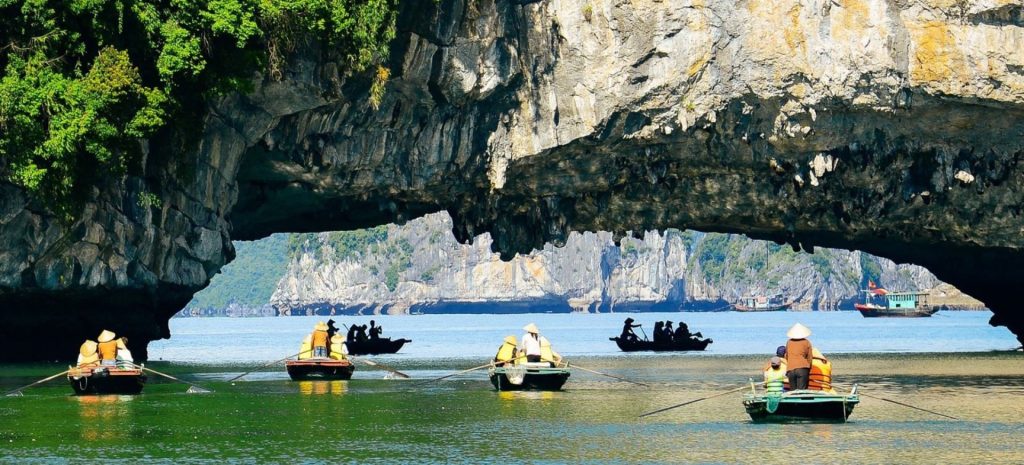
Luon Cave is all about the “hidden” experience. It is a natural tunnel carved through the mountain that is only about 60 meters long and 4 meters wide. You can only enter by kayak or small bamboo boat during low tide. Once you pass through the dark tunnel, you emerge into a secret, circular lake surrounded by vertical cliffs where wild monkeys often play in the trees.
4. Cua Van Floating Village

This village offers a peaceful escape from the more touristy areas. It is home to a community that has lived on the water for decades. The “houses” are built on floating rafts, and children even used to go to school on the water. It’s a great place to learn about traditional fishing techniques and see a lifestyle that is deeply connected to the sea.
5. Dau Go Cave (Wooden Stakes Cave)

While Sung Sot is known for its size, Dau Go is known for its mystery and history. It sits atop a 90-step climb and has three main compartments. The cave feels like an ancient castle with “stone curtains” hanging from the ceiling. Its name comes from a 13th-century legend where Vietnamese soldiers hid sharp wooden stakes here before using them to defeat the Mongol navy.
6. Tuan Chau Island
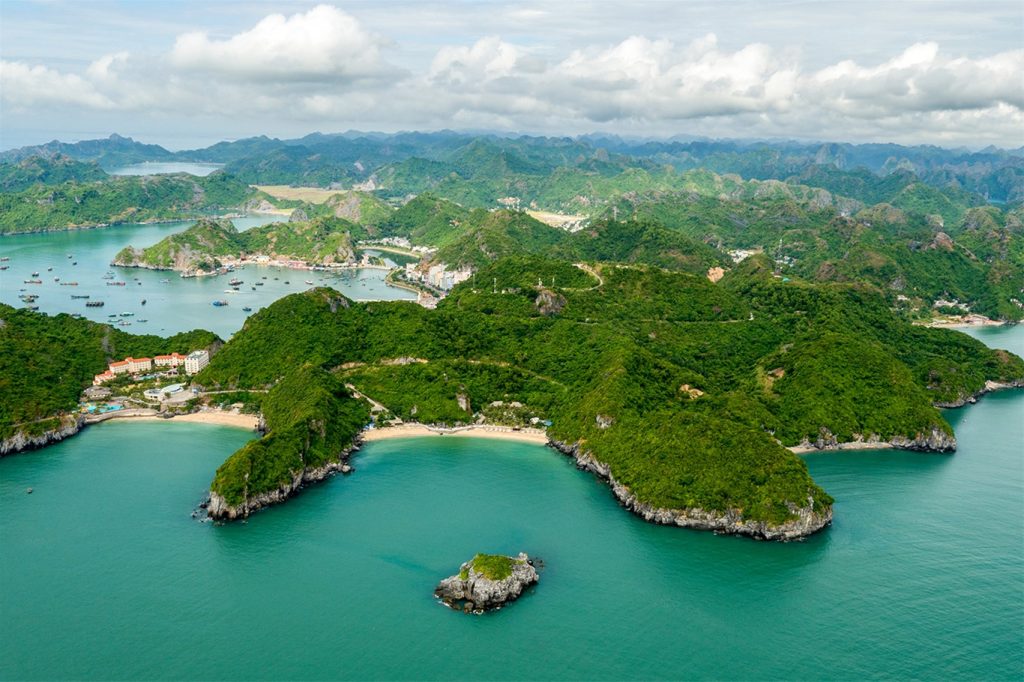
Unlike the wild limestone islands, Tuan Chau is a hub of modern luxury and activity. Connected to the mainland by a long bridge, it serves as the main departure point for most luxury cruises. It features a sprawling white-sand beach, a massive marina, and a dolphin show club. It’s the best place to stay if you want high-end resorts and easy access to both the city and the bay.
6. About Vietnam Tour 247

Vietnam Tour 247 offers a variety of tour packages to Halong Bay, one of Vietnam’s most renowned destinations. Here’s an overview of their Halong Bay tour:
Tour Options: Vietnam Tour 247 provides diverse tour options tailored to different preferences and budgets. They offer day trips, overnight cruises, and multi-day excursions, allowing visitors to explore Halong Bay and its surroundings at varying paces.
Itinerary Highlights: Depending on the chosen package, the itinerary may include visits to popular attractions such as Sung Sot Cave (Surprise Cave), Ti Top Island for panoramic views, fishing villages like Cua Van, and opportunities for kayaking in the bay’s tranquil waters.
Accommodation: Vietnam Tour 247 arranges stays aboard traditional Vietnamese junk boats or luxurious cruises for overnight tours. These accommodations typically feature comfortable cabins with private facilities, dining options, and onboard activities.
Activities: Tours include a range of activities such as swimming, snorkeling (where applicable), Tai Chi sessions at sunrise, cooking classes to learn local dishes, and enjoying sunsets from the boat’s deck.
Transportation: The tour includes transportation from Hanoi to Halong Bay and return. Depending on the package, this may be by bus or private car, with convenient pickup and drop-off at selected hotels in Hanoi.
Meals: Most tours include meals prepared onboard using fresh local ingredients. Special dietary requirements, including vegetarian options, can usually be accommodated with advance notice.
Guides: Knowledgeable guides fluent in English (and sometimes other languages) accompany the tours. They provide insights into Halong Bay’s history, culture, and natural features, enriching the tour experience.
Booking and Reviews: Booking can be conveniently done online through our website or travel agencies. Vietnam Tour 247 generally receives positive reviews for its customer service, tour organization, and the quality of the Halong Bay experience offered.
Vietnam Tour 247 ensures a comprehensive and enjoyable exploration of Halong Bay, catering to the diverse interests and needs of travelers seeking to discover this spectacular UNESCO World Heritage site.
7. In Conclusion
In addition, Ha Long Bay weather offers two distinct vibes. Spring and Autumn provide the most comfortable temperatures and clear skies, perfect for outdoor activities like hiking and photography.
Halong Bay weather in Summer is the best time for swimming and water sports due to the heat, though it brings a higher chance of rain. Conversely, Winter is cool and often misty, creating a “mystical” and quiet atmosphere that is ideal for exploring caves and relaxing on a cruise.
If you want to have a trip to Halong Bay, please contact us by:
- Website Vietnamtours247
- Hotline: (+84) 979133907
- WhatsApp: (+84) 916289247
- Email: sales@vietnamtour247.com
- Vietnam: 128 Ngoc Tri St, Long Bien District, Hanoi
8. FAQs
1. When is the “perfect” time to visit?
The best months are March to April (Spring) and October to November (Autumn). During these periods, the weather is mild, the skies are usually clear, and the sea is calm. It is neither too hot to hike nor too cold to enjoy the water, making it ideal for photography and sightseeing.
2. Is it safe to visit during the typhoon season?
Typhoon season typically runs from July to September. While it is generally safe, there is a risk of sudden cruise cancellations if a storm is approaching. If your cruise is cancelled by the Port Authority for safety, most reputable companies will offer a full refund or help you reschedule for the following day.
3. Can I still swim in the winter (December – February)?
It is usually too cold for most people to swim comfortably in the winter, as water temperatures drop significantly. However, you can still go kayaking or take a bamboo boat. If you visit during this time, focus on “mystical” activities like cave exploring, and make sure to pack a warm jacket for the chilly evenings on the deck.
4. Does the fog ruin the trip?
Not at all! Fog is common in late winter and early spring (January–March). While it might limit long-distance views, many travelers actually prefer it because it creates a “hidden world” atmosphere. The limestone peaks appearing and disappearing through the mist make the bay look like a traditional ink painting.
Read more:
- Cave In Halong Bay Vietnam: The Top 6 Must-See Places
- Places to stay in Halong Bay Vietnam
- Vietnam & Cambodia Discovery – 14 Day Touring




